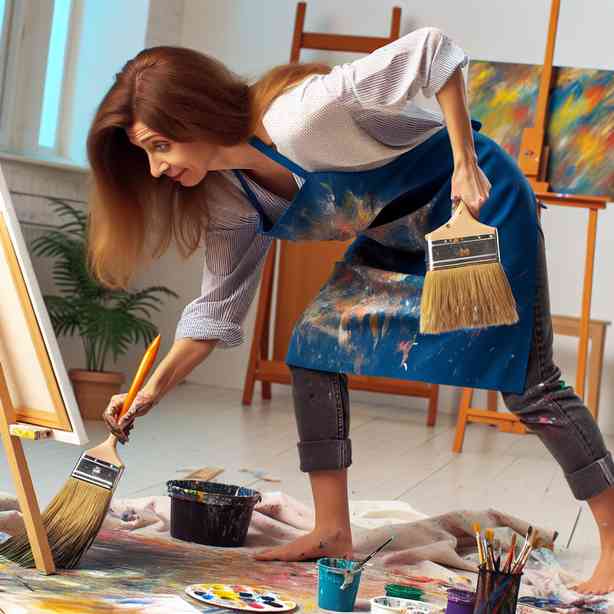
Creating art is a deeply personal and expressive endeavor. It often requires not just creative vision but also the right tools to bring that vision to life. However, what happens when one attempts to make art using tools that are not typically associated with the artistic process? The phrase “When You Made Art With the Wrong Tools” invites us to explore the concept of artistic experimentation, the boundaries of creativity, and the unexpected beauty that can arise from unconventional means.
Many artists, regardless of their medium, will attest to the essential role that tools play in the art-making process. A painter relies on brushes and palettes, while a sculptor may depend on chisels and clay. These tools are not merely instruments; they are extensions of the artist’s intent and expression. However, when an artist substitutes these traditional tools for unexpected objects—kitchen utensils, office supplies, or even natural materials—a fascinating dialogue begins. The intersection of art and unconventional materials opens up new pathways for creativity and innovation.
At the heart of this exploration lies the notion of constraint and liberation. Using non-traditional tools can impose limitations that, paradoxically, may fuel a new form of creativity. For instance, creating a painting with sponges, forks, or even your hands can prompt an artist to think differently about texture, color application, and composition. This approach encourages problem-solving and adaptability, allowing for a fresh perspective on what art can be. Instead of adhering to established techniques, artists may find themselves inventing new methods, resulting in artwork that is raw and authentic.
Consider the experience of an artist who decides to create a series of paintings using unconventional materials such as bubble wrap, old newspapers, or fabric scraps. The initial challenge of navigating these unfamiliar mediums can lead to moments of discovery. For example, the texture of bubble wrap can create fascinating patterns, while newspaper clippings can add depth and narrative layers to a piece. In this sense, the “wrong tools” become gateways to innovation, encouraging artists to step outside their comfort zones and explore new artistic identities.
Moreover, using the wrong tools can also challenge the art community’s perception of what constitutes art. In a world where the definition of art can often feel rigidly defined, breaking these conventions can inspire others to question the boundaries of artistic expression. This can lead to a broader dialogue about accessibility in art. When artists shift away from high-cost materials and tools, they invite a more diverse audience to engage in the creative process. Ordinary people, who may feel intimidated by the traditional art world, can find new ways to express themselves and share their unique perspectives through art.
This exploration also aligns with a growing movement within the art community that values sustainability and resourcefulness. As global concerns about waste and environmental impact increase, artists are becoming more conscious of their materials. Using unconventional tools can also mean repurposing discarded items, thereby promoting a culture of recycling and upcycling. This practice not only minimizes waste but also infuses art with a sense of purpose and message that resonates with contemporary audiences.
Handmade art created with unexpected tools often carries a unique emotional weight that can evoke powerful responses from viewers. The tactile nature of art made with alternative materials invites an intimacy that can be lost in more polished works. When someone creates with their hands—using the wrong tools—they engage in a physical dialogue with the materials that connects them more deeply to the process. This connection often results in pieces that resonate on a more profound level, eliciting emotions and thoughts that may not arise from traditional art-making.
Consider the power of collaborative art projects where community members contribute their creativity using everyday objects. In these situations, the “wrong tools” serve as a democratizing force in the world of artistry. Collaborators might use items as varied as spray paint cans, fabric remnants, or even their own body print to create a mural or installation. This process fosters a shared sense of ownership and pride, while simultaneously reinforcing the notion that artistic expression is inherently rooted in collective experience.
In addition to community engagement, utilizing unconventional tools can also lead to unexpected technical advancements. Artists who experiment with their methods may unknowingly discover new techniques or combinations of materials. For example, an artist who uses a broom to create sweeping brush strokes might inadvertently stumble upon a technique that blends painting and printmaking. This type of innovation is often what pushes art forward, leading to movements that can redefine genres and styles.
As we delve into the concept of creating art with the wrong tools, it becomes clear that such exploration is more than mere experimentation; it is about embracing imperfections. When artists work with materials not traditionally associated with their practices, they often encounter surprises—both pleasurable and challenging. These moments remind us that art is an evolving entity, and thus the process matters just as much as the final product. Seeing beauty in mishaps and accidents can liberate artists from the pressures of perfectionism, encouraging a more joyful and spontaneous approach to creation.
In closing, the exploration of artistic expression through the lens of using unconventional tools invites a rich conversation about creativity, innovation, and authenticity. The beauty of art lies in its ability to transcend boundaries, challenge norms, and inspire genuine connection. By embracing the unexpected and the unconventional, artists can find freedom in their work, allowing their voices to resonate in new and profound ways. Ultimately, when we create art with the wrong tools, we may discover not only new forms of expression but also uncover deeper truths about ourselves and our world—truths that might otherwise remain hidden within the confines of conventional artistry.


